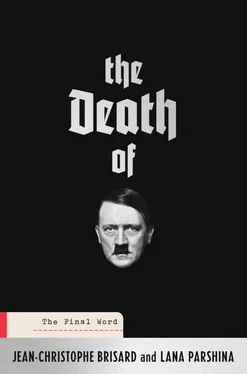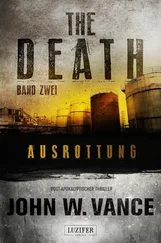In either case, the stories are far from neutral. But a comparison of the two sources does allow us to establish a fairly credible picture of the twelve last known days in the life of the German dictator. At least until the afternoon of 30 April 1945.
“Where are the Russians? Is the front holding? What’s the Führer doing? When is he leaving Berlin?”
(
Senior Nazi officials in the Führerbunker in Berlin )
In the Führerbunker, they were finally getting their smiles back. The order to flee should be coming soon! Escaping the bombing, and the Berliners who were becoming increasingly hostile to the Nazi regime. They were scheduled to leave the next day, 20 April, Hitler’s birthday. What better present could they hope for than an escape to the fortress of Berchtesgaden in the Bavarian mountains? That way he would be able to celebrate his fifty-sixth birthday under the milky sky of the German Alps that he loved so much. And most importantly, he would be leaving his bunker, that reinforced concrete mausoleum buried beneath the gardens of the new Reich Chancellery. Since mid-March, Hitler had transferred his quarters to this air-raid shelter right in the middle of the German capital.
The whole of the dictator’s entourage dreamed of that escape. From the Wehrmacht officers to the men who had been in the SS from the beginning, via the senior officials in the state apparatus, they were only waiting for a sign from Hitler to pack up all their belongings. Of course their haste to leave the front was officially dictated only by the need to preserve the physical health of the master of Germany and continue the fight. Few confessed their fear and wish to save their skin. How many people had taken refuge in the Chancellery? About fifty? Sixty? Hard to say. Every day, new people turned up at 77 Wilhelmstrasse and requested a place, a bed, in a dormitory or even a corridor. Technically speaking, the whole of the Führerbunker could hold two hundred people. More than that and they risked running out of oxygen in spite of the powerful ventilation system. The Führerbunker consisted of two underground shelters. First of all there was the Vorbunker, or “upper bunker,” buried 6 metres beneath the big hall of the New Chancellery. It was built in 1936 and extended over almost 300 square metres. It consisted of fourteen rooms with an area of 10 square metres each on either side of a 12-metre corridor. Created to resist the air attacks, its ceiling was 1.6 metres thick and its walls were 1.2 metres deep. Or exactly twice as thick as the shelter beneath the Aviation Ministry in Berlin. But it still wasn’t enough.
Hitler, after the first British bombing raids on Berlin in January 1943, ordered the construction of an even more solid bunker, the Hauptbunker, or “main bunker.” It was 2.5 metres deeper than the Vorbunker, or 8.5 metres underground. The two bunkers were connected by a staircase at right angles framed by airtight armoured doors capable of resisting a gas attack. The security norms in the Hauptbunker swept away all previous records. The walls were 4 metres thick. It was protected by a 3.5-metre layer of concrete and measured just under 20 metres wide by 15.6 metres long, a total of 312 square metres. [4] Sven Felix Kellerhoff, The Führer Bunker: Hitler‘s Last Refuge , Berlin, Berlin-Story-Verlag, 2004, p. 50.
The partition walls of the rooms were designed to resist large-scale bombing attacks. They were 50 centimetres thick. Creature comforts were few. No parquet on the floor, no carpet, and only the barest minimum in terms of furniture. Damp was a constant presence at this depth. The pumps with the task of removing any water that seeped in did not prevent the sensation of damp and cold. The walls were painted grey or left bare. Because of the thickness of these partitions, the rooms were even smaller than in the Vorbunker. Even the ones attributed to Hitler were no more than 10 square metres in area and 3 metres high. There were six tiny rooms for the military personnel opposite his apartments. The only luxuries for the Führer were a personal bathroom, an office, and a bedroom. These rooms, unlike the rest of the shelter, were thoughtfully furnished.
“Hitler had his own bunker with only a few rooms for himself, his doctor, his manservant and the staff absolutely necessary for his team,” [5] Hans Baur, I was Hitler’s Pilot , London, Muller, 1958, p. 180.
his personal pilot, Hans Baur, remembered in his memoirs. The men that Hitler didn’t want to be separated from included: his personal doctor, Dr. Theodor Morell; his secretary, Martin Bormann; his aide-de-camp, Otto Günsche; and his valet, Heinz Linge. There was also Blondi, the Führer’s dog. She was sometimes locked up in the room where the daily strategic meetings were held. Eva Braun returned to the shelter of the New Chancellery early in April. Hitler didn’t know whether to be furious or delighted that his companion had the audacity to venture into the heart of battle. Be that as it may, he accepted her presence near him and ordered a bedroom to be assigned to her next to his own. She would be in safety there, he thought.
At least for now. Because the two bunkers soon risked being turned from refuges into a death trap if the order to flee the capital was not given quickly. The military situation was catastrophic. Since 16 April, Russian troops led by Marshals Georgy Zhukov and Ivan Konev launched their big offensive on Berlin. For now, they were still some way away fighting about a hundred kilometres east of the Reich capital, on the River Oder. But all the German officers knew that the city would be difficult to defend. Vast in area, with a large urban conglomeration, Berlin required too much effort in terms of men and materials to be protected. Hitler couldn’t ignore it. And yet he didn’t order the evacuation of the civilian population. By the time the fighting extended as far as the central district around the Brandenburg Gate, Berlin was still refuge to 2.5 million inhabitants.
At first, with resolute speeches and slogans, Nazi propaganda tried to transform the Oder into the last natural bulwark against the vengeful invasion of the Soviet soldiers. Muddy water against the wave of Russian steel–an image that might carry a certain panache in a Wagner opera, but in the spring of 1945 it looked like collective suicide.
The idea of suicide wasn’t displeasing to Hitler. Not his own, but that of his people. Suicide as the ultimate sacrifice to his murderous ideology.
To persuade public opinion to go on fighting, the Nazi dictator joined in personally. In early March he went to the front line at the Oder. It would be his last official outing into the combat zone. The intention was to show the Germans that their Führer was in control of the situation. The slogans proclaimed in the papers and cinema newsreels sought to be sober and martial: “The Führer in person is on the front line of the Oder!” and “The defence of Berlin is being carried out on the Oder.” But it had been a month since then… and another era, the era of hope.
If war is a matter of will, sacrifice, and, sometimes, tactical genius, most often it is based around the simplest mathematics. Stalin knew that all too well. And he didn’t stint on the forces deployed. Against a million German soldiers, the master of the Kremlin assembled over twice as many men, 2.1 million. Most importantly, the Russians were better equipped: 41,600 pieces of artillery, 6,250 tanks, and 7,500 fighter planes against 10,400 pieces of artillery, 1,500 tanks, and 3,300 fighter planes on the Nazi side.
Hitler’s generals were well aware of this. If the Red Army crossed the Oder, Berlin would only hold out for a few days. But that wasn’t serious because provision had been made for everything in the Nazi camp. The battle would be fought in the “Alpine redoubt” towards Bavaria and Austria, in a mountainous triangle between Salzburg, Bad Reichenhall, and Berchtesgaden. Since mid-March, the Führer’s secretariat had given orders to transfer the Nazi state apparatus there. A network of bunkers was built, specially connected by telephone lines. Even the Chancellery’s fleet of cars had been sent there.
Читать дальше












